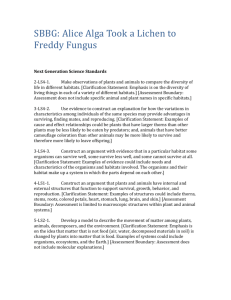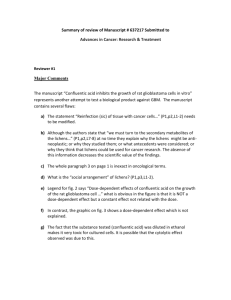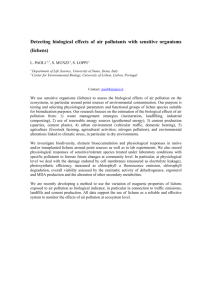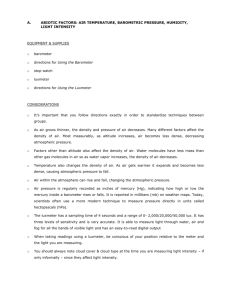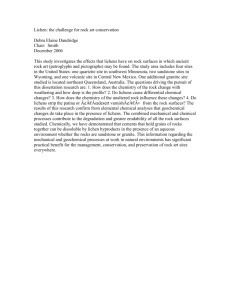Abstract
advertisement
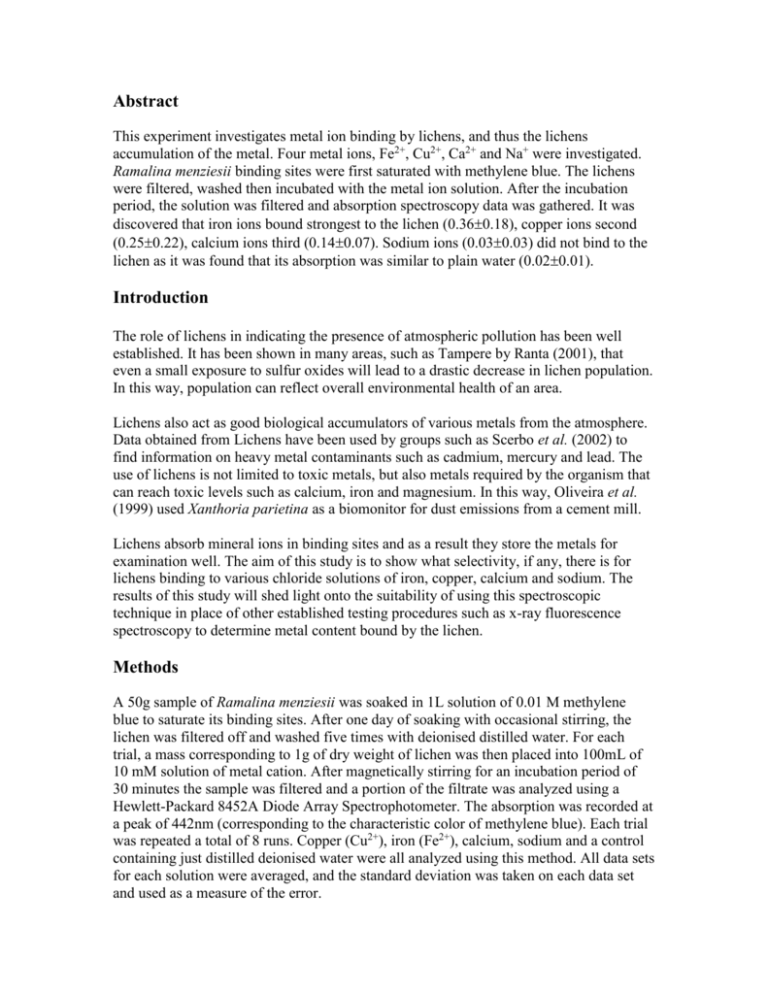
Abstract This experiment investigates metal ion binding by lichens, and thus the lichens accumulation of the metal. Four metal ions, Fe2+, Cu2+, Ca2+ and Na+ were investigated. Ramalina menziesii binding sites were first saturated with methylene blue. The lichens were filtered, washed then incubated with the metal ion solution. After the incubation period, the solution was filtered and absorption spectroscopy data was gathered. It was discovered that iron ions bound strongest to the lichen (0.360.18), copper ions second (0.250.22), calcium ions third (0.140.07). Sodium ions (0.030.03) did not bind to the lichen as it was found that its absorption was similar to plain water (0.020.01). Introduction The role of lichens in indicating the presence of atmospheric pollution has been well established. It has been shown in many areas, such as Tampere by Ranta (2001), that even a small exposure to sulfur oxides will lead to a drastic decrease in lichen population. In this way, population can reflect overall environmental health of an area. Lichens also act as good biological accumulators of various metals from the atmosphere. Data obtained from Lichens have been used by groups such as Scerbo et al. (2002) to find information on heavy metal contaminants such as cadmium, mercury and lead. The use of lichens is not limited to toxic metals, but also metals required by the organism that can reach toxic levels such as calcium, iron and magnesium. In this way, Oliveira et al. (1999) used Xanthoria parietina as a biomonitor for dust emissions from a cement mill. Lichens absorb mineral ions in binding sites and as a result they store the metals for examination well. The aim of this study is to show what selectivity, if any, there is for lichens binding to various chloride solutions of iron, copper, calcium and sodium. The results of this study will shed light onto the suitability of using this spectroscopic technique in place of other established testing procedures such as x-ray fluorescence spectroscopy to determine metal content bound by the lichen. Methods A 50g sample of Ramalina menziesii was soaked in 1L solution of 0.01 M methylene blue to saturate its binding sites. After one day of soaking with occasional stirring, the lichen was filtered off and washed five times with deionised distilled water. For each trial, a mass corresponding to 1g of dry weight of lichen was then placed into 100mL of 10 mM solution of metal cation. After magnetically stirring for an incubation period of 30 minutes the sample was filtered and a portion of the filtrate was analyzed using a Hewlett-Packard 8452A Diode Array Spectrophotometer. The absorption was recorded at a peak of 442nm (corresponding to the characteristic color of methylene blue). Each trial was repeated a total of 8 runs. Copper (Cu2+), iron (Fe2+), calcium, sodium and a control containing just distilled deionised water were all analyzed using this method. All data sets for each solution were averaged, and the standard deviation was taken on each data set and used as a measure of the error. Results Mean Absorbancy As can be seen in Figure 1, a general trend was noticed with the absorption of metal ions by the lichens. Iron ions bound more tightly than copper ions than calcium ions and sodium’s binding affinity was not statistically different from the control of distilled water. (Fe2+ < Cu2+ < Ca2+ < Na+ ~ control) 0.60 0.50 0.40 0.30 0.20 0.10 0.00 Iron Copper Calcium Sodium Control Metal cation Figure 1. A comparison of metal ion absorption from a 10 mM metal chloride solution by lichens as measured by the release of methylene blue from saturated lichen binding sites. Iron cations (Fe2+) bound to the active sites most tightly, releasing a quantity of methylene blue corresponding to an absorption of 0.360.18. Copper cations (Cu2+) bound less tightly with a significantly wider range of values, 0.250.22. Calcium cations bound less tightly yet showing an absorption of 0.140.07. Sodium cations did not show a statistically different binding when compared to the control. The sodium cations released a quantity of dye corresponding to an absorption of 0.030.03. The control, that consisted of just water, showed an absorption of 0.020.01. Literature Cited Oliveira G., Branquinho C., C. Maguas C. and O. Correia. 1999. Spatial impact of atmospheric dust from a cement mill in Serra da Arrabida, using lichens as biomonitors. Biological Abstracts 17 (1-4) 33-42. Ranta P. 2001. Changes in urban lichen diversity after a fall in sulphur dioxide levels in the city of Tampere, SW. Biological Abstracts 38 (4) 295-304. Scerbo R., Ristori T., Possenti L., Lampugnani L., Barale R. and C. Barghigiani. 2002. Lichen (Xanthoria parietina) biomonitoring of trace element contamination and air quality assessment in Pisa Province (Tuscany, Italy). Sci Total Environ 286 (1-3): 27-40. Note to marker: I took some artistic liberty with this write up, I don’t know if it was what you were looking for but hope you enjoyed reading it nonetheless. Spectroscopic analysis of metal ion absorption by Ramalina menziesii using methylene blue Written by John Stephenson (410-1306) Prepared for Rob Snetsinger Department of Biology, Queen’s University, Kingston, Ontario Biology 101 (Spring 2002)



